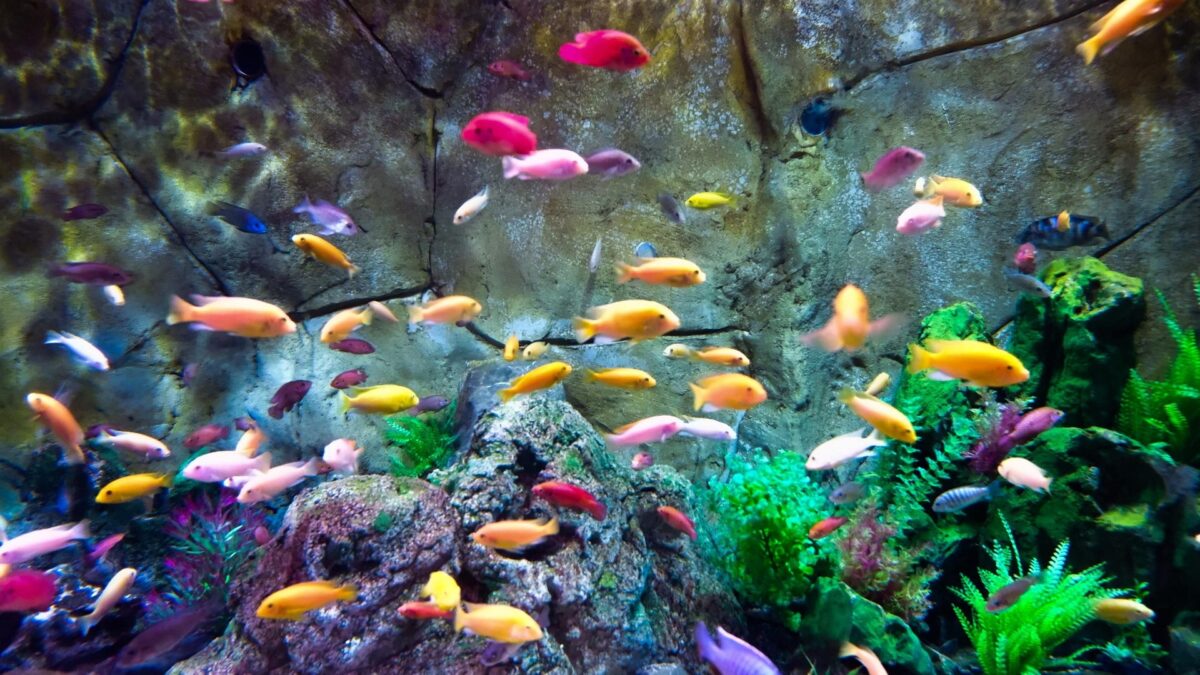In recent years, there has been a growing trend among aquarium enthusiasts of keeping freshwater fish. While there are many reasons to keep fish as pets, one of the most appealing aspects is their wide range of colors and patterns.
For many people, the word “fish” conjures up images of dull gray or brown creatures swimming aimlessly in murky water. However, there are actually many freshwater fish that are brightly colored and full of personality.
In this article, we’ll take a closer look at the 23 most popular colorful freshwater fish for aquariums. Whether you’re a beginner or an experienced aquarist, read on to learn more about these beautiful creatures.
Contents
1. Peacock Cichlid
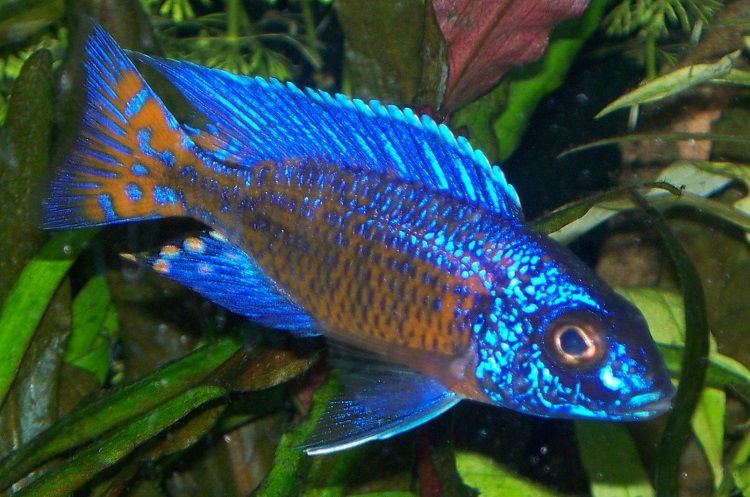
Scientific Name: Aulonocara
Lifespan: 6-8 years
Average Size: 4-6 inches
Tank requirement: 55-60 gallons
This Eastern Africa-native lives at the bottom of the water where they search for food. They are known for being skillful swimmers and are considered the friendliest Cichlids. They are low-maintenance fish and are very submissive.
Peacock Cichlids have different color schemes like yellow, gold, blue, and orange.
Environment
Peacock Cichlids will survive in an environment that looks like their natural habitat. The water’s temperature should be around 74°F to 82°F, pH level should be 7.5 and 8.5, and water hardness must be 4 to 6 dH.
This fish usually stays at the bottom so you should not use gravel for your substrate because that would damage your Peacock Cichlids’ gills.
Use soft and sandy materials and put rocks or driftwood that will serve as their hiding place so that there will be conflicts in terms of territory.
Food and Diet
Peacock Cichlids are generally omnivores and predators so they like feeding on invertebrates like insects as well as crustaceans.
They will also like live or frozen brine shrimp and common water fleas. One of the basics of their diet is a good kind of pellet that sinks at the bottom of their tank.
2. Jack Dempsey
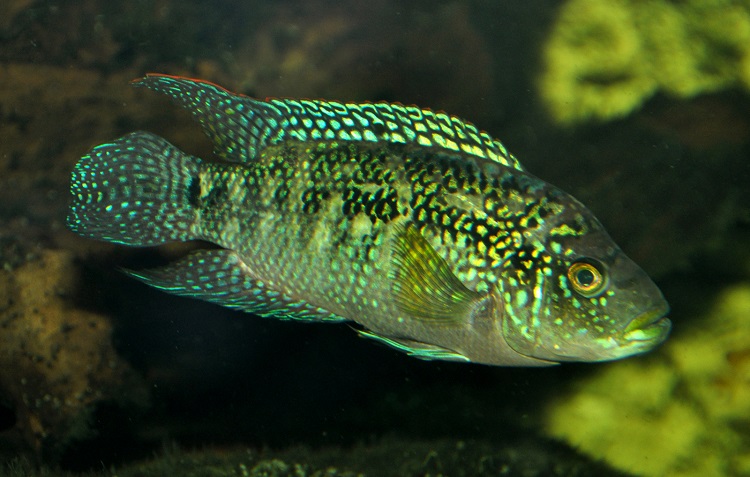
Scientific Name: Rocio Octofasciata
Lifespan: 8 to 10 years
Average Size: 10 – 15 inches
Tank requirement: 80 gallons
This fish is a species of Cichlid fish that is native to freshwater habitats in Central America. It is typically a brown or green color with black spots.
Jack Dempsey is known for its aggressive and territorial behavior. It establishes territory in an aquarium and will defend it against other fish.
Environment
This fish prefers to live in warm water with a pH range of 6.5-7.5, water temperature of 75-85°F, and water hardness of 9-20 dH.
The aquarium should be decorated with rocks and caves for the fish to hide in.
Food and Diet
This fish requires a diet that is high in protein. Its diet should include a variety of meaty foods such as worms, crickets, and shrimp.
Good-quality Cichlid pellets or flakes can also be used as the base of the diet.
3. Electric Blue Acara
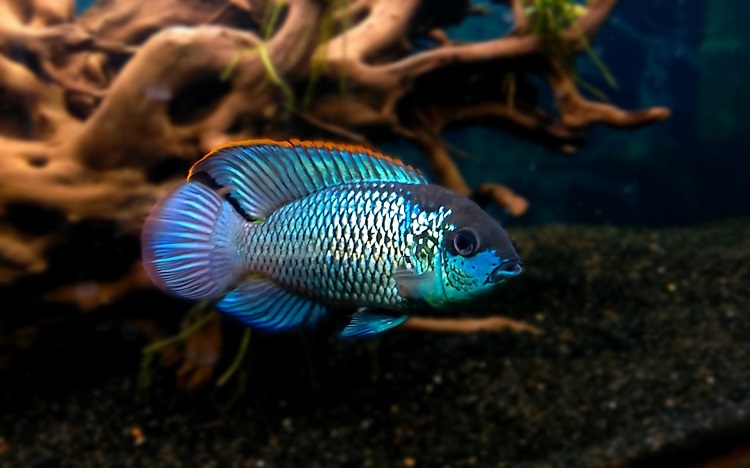
Scientific Name: Andinoacara Pulcher
Lifespan: 10-20 years
Average Size: 6-8 inches
Tank requirement: 30 gallons
Electric Blue Acara is a Cichlid fish species from South America. This fish is easily recognizable due to its vibrant blue coloration.
The body of the fish is covered in electric blue scales, while the fins are often yellow or orange.
They are not aggressive towards other fish, and they will even coexist peacefully with fish of different species.
Environment
This fish prefers water temperature that is between 75-82°F. The pH of the water should be between 6.5-7.5, and the hardness should be between 5-15 dH.
It is important to keep the Electric Blue Acara in a big tank as they need plenty of room to swim and explore. The tank should be well-decorated with plenty of hiding places and structures.
Live plants are a great addition to the tank, as they provide cover for the fish and help to keep the water clean.
Food and Diet
The Electric Blue Acara should be fed a diet that consists of both meaty and vegetable-based foods.
Some good food options for them include pellets, flakes, live or frozen brine shrimp, live or frozen Bloodworms, and blanched vegetables like zucchini or spinach.
4. Oscar Fish
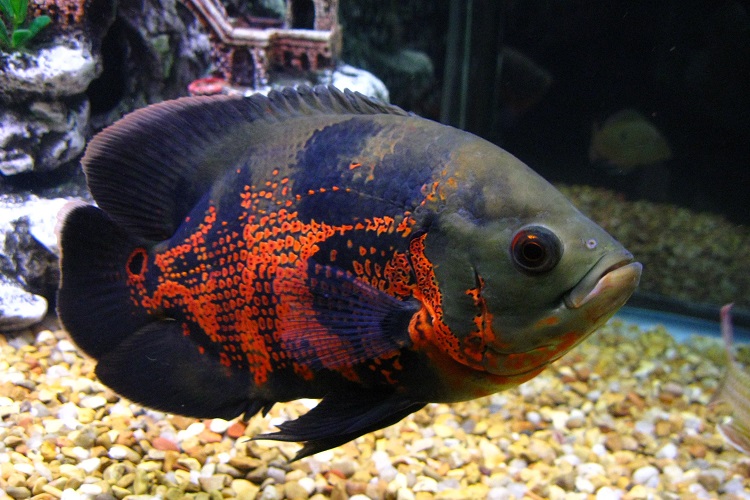
Scientific Name: Astronotus Ocellatus
Lifespan: 15-20 years
Average Size: 10-12 inches
Tank requirement: 55 gallons
The Oscar fish originates from the rivers of South America. They are known for their bold personalities and their usual colors: orange, yellow, and albino.
While they are relatively easy to care for, Oscars can be aggressive towards other fish and should only be kept with other peaceful species.
Environment
They prefer water that is between 74-81°F, a pH level of 6-8, and water hardness of 5-20 dH. The Oscars should have access to hiding places and require plenty of open swimming space.
To mimic their natural habitat, you can use sandy and soft substrate combined with vegetation, debris, and rocks. Note that they are messy eaters so their aquarium requires good filtration.
Food and Diet
Live foods such as brine shrimp, earthworms, and crickets are favorites among Oscars. In addition, Oscars should also be given vegetables such as zucchini, peas, and spinach.
5. German Blue Ram
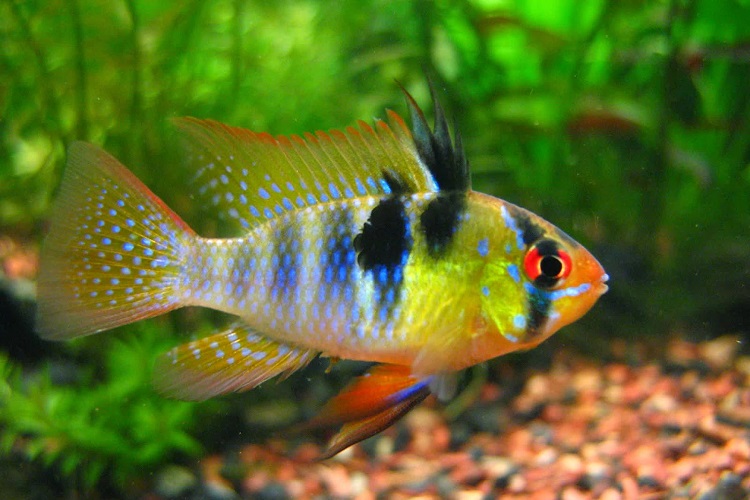
Scientific Name: Mikrogeophagus Ramirezi
Lifespan: 2-4 years
Average Size: 2-3 inches
Tank requirement: 10 gallons
Native to South America, they can be found in the Orinoco River basin in Venezuela and Columbia.
They are very peaceful fish and do well in community tanks. Their usual colors are a powder blue body with electric blue fins, but they can also be found in other colors like yellow and white.
Environment
German Blue Rams prefer waters with a temperature of 78-86°F. They do best in soft water (6-14dH), and slightly acidic water (6.0-7.5 pH), but they are adaptable and can thrive in a variety of conditions.
Food and Diet
They will eat most kinds of prepared aquarium foods, as well as live or frozen foods.
Bloodworms, brine shrimp, and Daphnia are all good choices. Live plants can also be a good source of food for these fish.
6. Cherry Barb

Scientific Name: Puntius Titteya
Lifespan: 5-6 years
Average Size: 1-2 inches
Tank requirement: 25 gallons
Native to Sri Lanka, this aquarium fish is known for its vibrant red coloration and friendly disposition.
Though relatively small, they are lively and active swimmers that will add interest and activity to any community tank.
They are also known to be fin nippers, so it is best to keep them with similarly sized tank mates that are not prone to bullying.
Environment
The water in their tank should be between 73-81°F, should have a moderate level of humidity, and water hardness of 4-15 dH.
This colorful freshwater fish will need lots of hiding places in the form of plants and caves.
Food and Diet
They are not particularly fussy eaters and will accept a variety of foods. A well-balanced diet rich in vegetables and algae will help to bring out their vibrant colors.
Some good food options for them include vegetables like blanched spinach and zucchini, and Algae such as spirulina, and chlorella.
They also like fruits like melon and berries as well as live and frozen food like brine shrimp, Bloodworms, and Daphnia.
7. Green Terror Cichlid
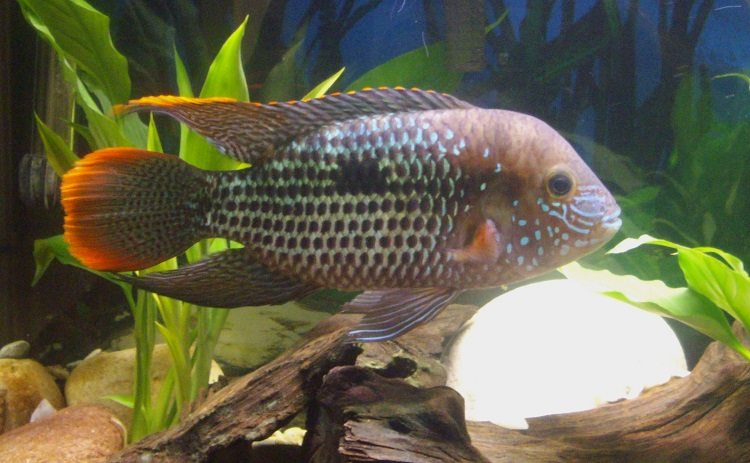
Scientific Name: Andinoacara Rivulatus
Lifespan: 7-10 years
Average Size: 12 inches
Tank requirement: At least 35 gallons
This freshwater fish is native to the rivers of South America. This fish is known for its beautiful green and blue coloration.
They are ray-finned so their fins consist of a web of bony skin that is attached to their body just like rays. It can be difficult to care for this fish due to its aggressive nature.
Environment
They require plenty of hiding places in their tank, so rocks, caves, and driftwood should be added.
The Green Terror Cichlid needs plenty of places for them to hide. Their tank’s water temperature should be kept between 72-82°F, the pH level should be 6.5-7.5, and water hardness needs to be 5-20 dH.
Food and Diet
Commercial Cichlid pellets or flakes can be supplemented with live foods such as brine shrimp or Bloodworms.
These fish will also consume vegetables such as zucchini, spinach, and peas.
8. Gourami
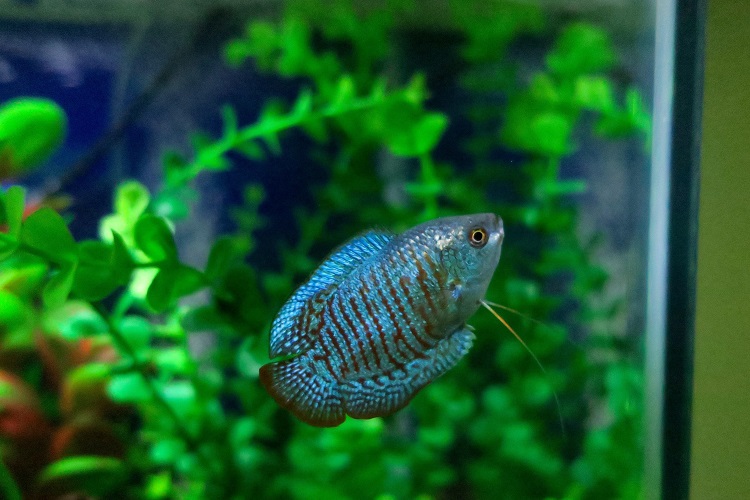
Scientific Name: Trichogaster Trichopterus
Lifespan: 3-8 years
Average Size: 3.5-28 inches
Tank requirement: Minimum of 10 gallons
The Gourami is native to Southeast Asia. It is a peaceful fish and is often kept with other peaceful fish such as the betta.
Considered a labyrinth fish, it can breathe air from the surface of the water. The Gourami is a popular aquarium fish due to its beautiful colors like blue, yellow, orange, red, and brown.
Environment
Gouramis can survive in a wide range of water temperatures. However, they prefer temperatures between 72-82°F. Water should be neutral or slightly acidic (6.0-8.0pH), with a hardness of 4-15 dH.
Diet and Food
Gouramis eat larvae, small insects, and algae. They should also be fed a variety of vegetables such as spirulina, zucchini, and broccoli.
This freshwater fish is not a picky eater and will consume flakes, and pellets.
9. Zebra Danio
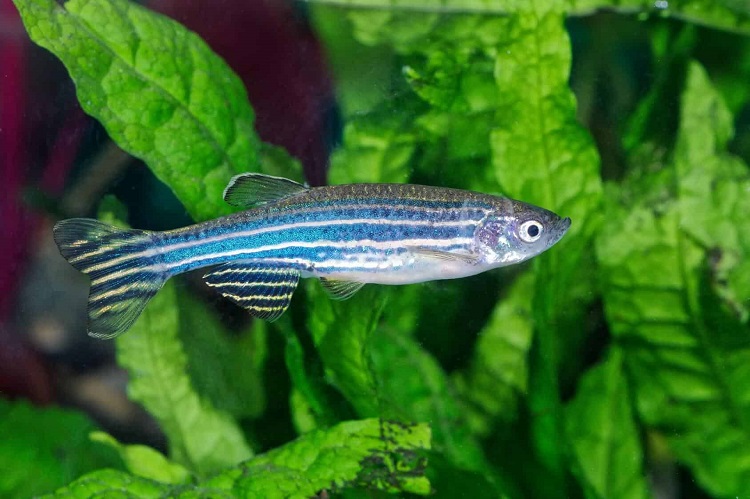
Scientific Name: Danio Rerio
Lifespan: 3-5 years
Average Size: 1.5-2.5 inches
Tank requirement: 10 gallons
Native to southern and Southeast Asia, it is an active and energetic schooling fish that will do well in a community aquarium with other peaceful species of similar size.
A hardy fish, Zebra Danio can be one of the easiest fishes to care for and is often recommended as a good beginner fish.
They are characterized by their long, slender bodies and their horizontal stripes that run the length of their bodies. These stripes can be green, blue, gold, or brown in coloration.
Environment
Zebra Danios are very active and need plenty of space to swim. They prefer water that is clean and well-oxygenated with a pH level between 6.8-8.0.
They can tolerate a wide range of temperatures, but prefer temperatures between 64-77°F, with a water hardness of 5-19 dH.
Food and Diet
You can feed them with fish flakes, algae wafers, and greens like spinach and cucumber.
They also eat live or frozen foods like Daphnia and Bloodworms, which will be their source of protein.
10. Dwarf Gourami
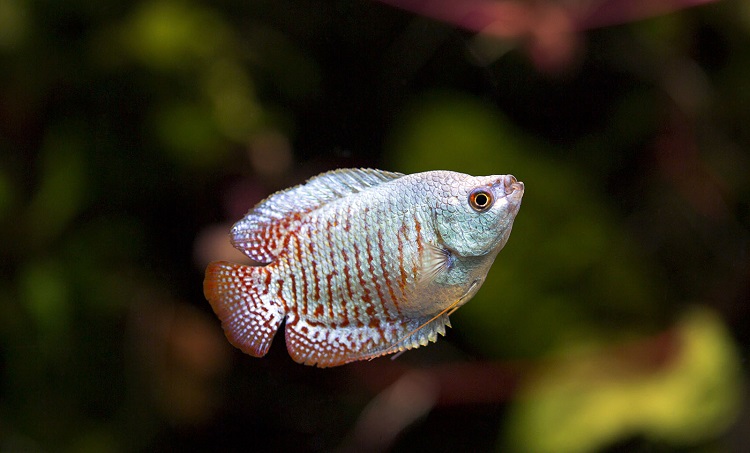
Scientific Name: Trichogaster Lalius
Lifespan: 5 years
Average Size: 4-4.5 inches
Tank requirement: 10 gallons
This peaceful and shy fish is native to Southern Asia. Dwarf Gouramis look unique and have quite a colorful appearance of blue, honey, red, and orange. Their bodies are narrow, and their fins are large and round.
Gouramis prefer to stick together when possible so they can feel secure and comfortable. They are usually found in the middle or top level of the tank.
Environment
Dwarf Gouramis can adapt to temperature swings quite well, but the best environment for them has a water temperature of 77–78.5°F, hardness of 10–20 dH, and pH level of 6-8.
So that they will look more striking and visible, use a dark substrate. Also, you can add free-floating and drifting plants in your tank so your fish will have a place to hide and build nests.
Diet and Food
Dwarf Gourami needs a varied diet that consists of algae-based foods and meat-based foods.
This fish will eat tablets, flakes, and frozen food as well as larvae from the bottom of the water, algae on plants, and small insects.
11. Betta Fish
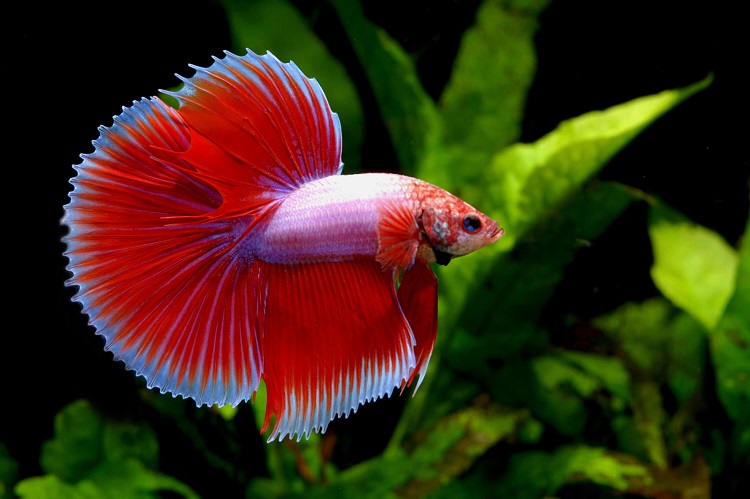
Scientific Name: Betta Splendens
Lifespan: 3 years
Average Size: 2.5inches
Tank requirement: 10 gallons
Native to Southeast Asia, Betta fish, also known as Siamese Fighting Fish, come in a wide variety of colors and patterns, like red, blue, green, purple, yellow, and white.
They are notorious for their aggressive nature and often engage in elaborate displays of dominance and aggression when kept with other fish.
Environment
Bettas require warm water to thrive. An aquarium heater is necessary to maintain a consistent water temperature of 75-80°F. They also prefer an environment with less water disturbance, with a pH of 6.5-7.
This colorful freshwater fish also likes well-filtered tanks with plenty of hiding places. Live plants are a great way to provide both shelter and oxygenation for your Betta.
Food and Diet
Bettas prefer live or frozen meaty foods like brine shrimp, Bloodworms, or Daphnia. They should be fed 2-3 times a day, and only as much as they can eat in one sitting.
12. Flowerhorn Cichlid

Scientific Name: Paracheirodon Innesi
Lifespan: 10-12 years
Average Size: 10-16 inchesI
Tank requirement: 70 gallons
Flowerhorns are a man-made species, created through selective breeding of various African Cichlid species. They are very territorial, but they are more known for their vibrant colors like orange, red, and yellow.
Environment
Flowerhorns need a lot of space to move around. These fish are also messy eaters, so a good filtration system is a must for your tank. They prefer water with 80–89°F, and a pH level of 6.5-7.8.
To give them a more comfortable habitat, a combination of mono-colored gravel, pebbles, and driftwood for the tank substrate is your best choice.
Food and Diet
Flowerhorns are omnivorous. A variety of frozen, freeze-dried, and pellet foods can be offered, along with fresh vegetables and fruits.
It’s important to feed Flowerhorns several small meals per day rather than one large meal.
13. Killifish
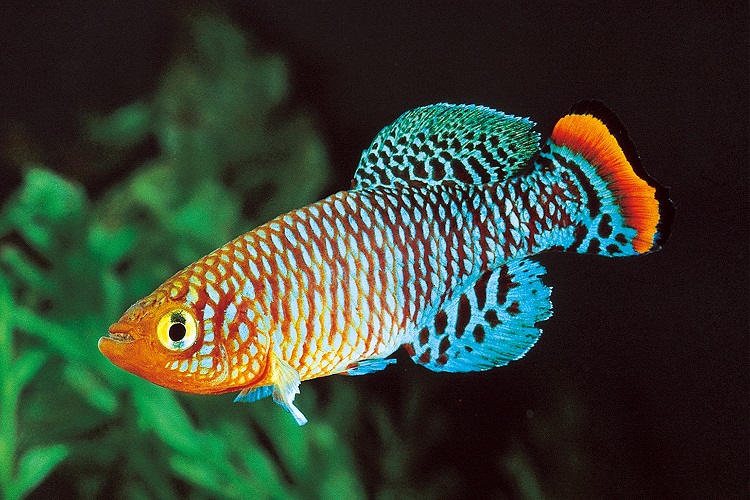
Scientific Name: Fundulus Diaphanus
Lifespan: 3 months to 5 years, depending on species
Average Size: 2-9cm
Tank requirement: 20 gallons
Killifish are native to Africa, Asia, and Europe. They come in a variety of colors, including brown, black, and green.
The majority of Killifish are slim and pike-shaped, making them excellent swimmers. Some have a more cylindrical body with short rounded fins, while others have long broad fins.
The shape of the body varies from species to species, although they all have a rear dorsal fin set toward the back half of their bodies.
Environment
To keep a Killifish in captivity, your aquarium should be equipped with a filter and a heater set to a temperature between 75-82°F.
When choosing plants for your aquarium, it is important to choose ones that will not uproot easily as Killifish like to dig and may uproot plants in their search for food.
Some good plant choices include Hornwort, Anacharis, and Java Moss.
Food and Diet
They can be fed a variety of foods, including live food, frozen food, and flakes or pellets designed for small fish.
Some of the foods that you can feed them are Tubifex worms, brine shrimp, black and white worms, and Daphnia.
14. Discus
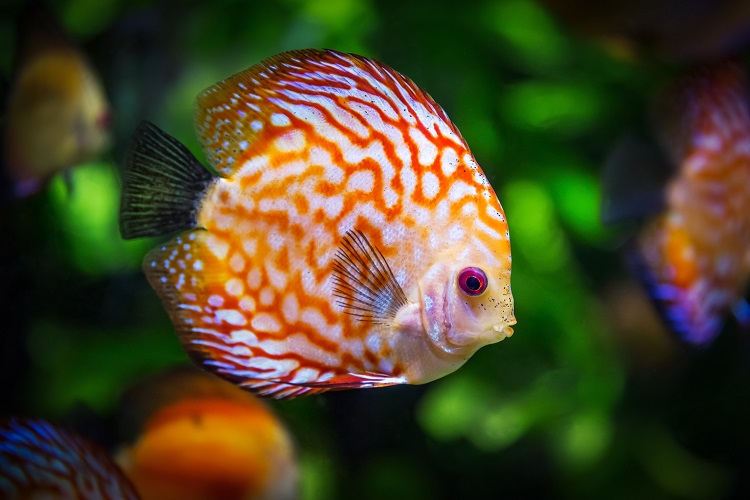
Scientific Name: Symphysodon Aequifasciatus
Lifespan: 10 years
Average Size: 8-10 inches
Tank requirement: 50 gallons
Discus are native to the Amazon River Basin in South America.
There are many different colors of Discus like heckle, brown, blue, and green, but they all have a round body shape and a laterally-compressed profile. Discus are peaceful fish that do well in groups.
Environment
Discus prefers to be in the water with a temperature between 82-86°F.
They are sensitive to water quality so it’s better to add them to an established aquarium that has been stabilized for at least six weeks.
Food and Diet
They should be given a diet that includes both meaty and vegetative items. Live, frozen, or freeze-dried foods are all good choices for your Discus.
Some good meaty foods for Discus include Bloodworms, brine shrimp, Daphnia, Earthworms, krill, and Tubifex worms, while some vegetative foods for Discus are blanched vegetables, algae sheets, cucumber slices, and lettuce leaves.
15. Fancy Guppies
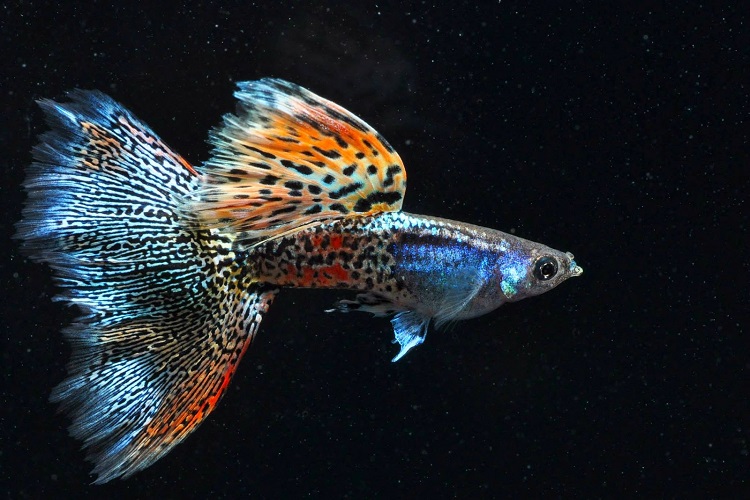
Scientific Name: Poecilia Reticulata
Lifespan: 2 years
Average Size: 0.6–2.4 inches
Tank requirement: 5 gallons
These lively little fish originate from South America and Trinidad.
Guppies come in different colors, including blue, green, yellow, orange, pink, and red. This colorful freshwater fish is also known for its long fins, which can be either flowy or spiked.
Guppies are relatively easy to care for, and they are peaceful fish so they can be kept with other peaceful species.
Environment
Guppies prefer warm waters and do best in an aquarium with a temperature between 72-82°F, and they prefer neutral waters that are neither too acidic nor too alkaline.
Guppies are also sensitive to high levels of chlorine, and they like tanks with plenty of hiding places.
16. Duboisi Cichlid
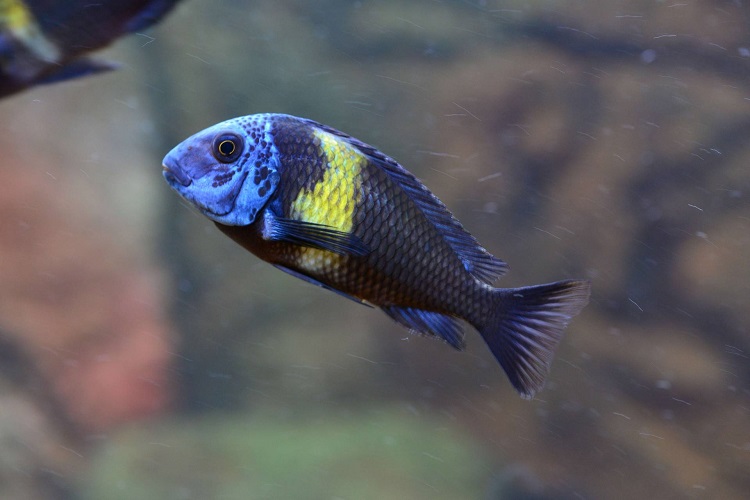
Scientific Name: Tropheus Duboisi
Lifespan: 5-8years
Average Size: 5 inches
Tank requirement: 50 gallons
The Duboisi Cichlid is endemic to Lake Tanganyika in Africa. The young Duboisi Cichlid looks gorgeous with an entirely black body, covered with bluish or white dots all over.
On the other hand, an adult Duboisi Cichlid has a blue or blue-gray head, complementing the overall dark slate to an almost black body and fins.
By nature, this freshwater fish is very aggressive and uncooperative. They don’t make friends or play with others so it’s best to have a separate tank for them.
Environment
It’s important to replicate their natural habitat as much as possible. You’ll need a sandy substrate and put some rocks and caves that will serve as their hiding places.
The tank should contain water with a pH of 8.0-9.0, hardness of 10-20 dH, and a temperature of 77-86°F.
This fish is accustomed to a highly oxygen-rich setting so these Cichlids require bubblers that provide continuous pumping of oxygen into the tank.
Food and Diet
The Duboisi Cichlids’ diet consists of small invertebrates, crustaceans, and algae. You can feed with commercial foods, including pellets, flakes, and frozen foods.
17. Harlequin Rasboras
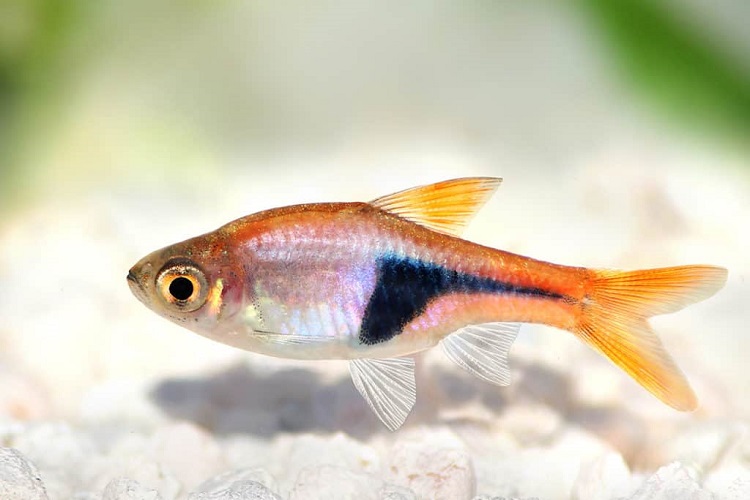
Scientific Name: Trigonostigma Heteromorpha
Lifespan: 5-8 years
Average Size: Up to 2 inches
Tank requirement: 10 gallons
Harlequin Rasboras are a peaceful schooling fish that originated from Southeast Asia. They are relatively easy to care for, and they make a great choice for beginner aquarists.
This fish has a striking contrast between red-orange and black. The area around the anus may or may not have an orange spot on the fin. This fish is very active, and they enjoy swimming in open areas of the aquarium.
Environment
It is important to provide them with plenty of hiding places and vegetation. These fish are very active, so be sure to include some open space in the aquarium for them to swim.
Water parameters are not too critical for these fish, but they prefer slightly acidic water with a pH between 6.0 and 7.5. They also prefer soft water with a hardness of 10 dH or less, with a temperature between 72-79°F.
Food and Diet
In the wild, they primarily eat small insects and larvae. In the aquarium, they will accept a variety of foods including flakes, pellets, live food, and frozen food.
It is important to provide them with a varied diet to keep them healthy.
18. Celestial Pearl Danio
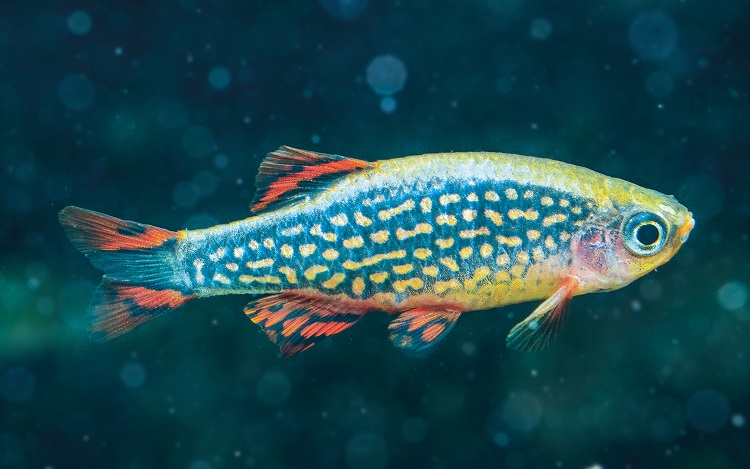
Scientific Name: Danio Margaritatus
Lifespan: 3-5 years
Average Size: 0.75–1 inch
Tank requirement: 10 gallons
The Celestial Pearl Danio originated from Myanmar. They have a thin, fusiform body with prominent fins. It is a brightly-colored fish, with iridescent blue and gold stripes.
Males are thinner and more brilliant, with a deep blue body dotted with pearlescent spots all over the flanks. These dots may be arranged in rows or in a galaxy pattern.
The female Celestial Pearl Danio is usually a little duller in color than the male.
Environment
They prefer water with a pH level of 6.5-7.0 and water hardness of 1-5dH. They do best in an aquarium with a water temperature of 71–78°F with plenty of hiding places and plants.
This fish resides in the tank’s lowest strata, where it hides among aquatic plants and rocks. They like moderately bright lighting, so it is best if you use LED lights for your tank.
Food and Diet
Their diet includes flake food, pellets, live food, and frozen food. To keep them healthy and vibrant, it is important to include some live or frozen foods in their diet.
Bloodworms, brine shrimp, Moina, frozen cyclops, and Daphnia are all good choices.
19. Neon Tetra
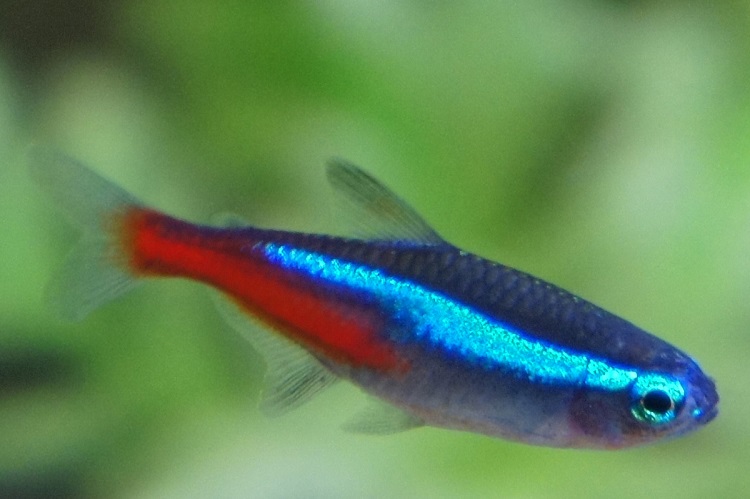
Scientific Name: Paracheirodon Innesi
Lifespan: 6-8 years
Average Size: 1–1.5 inches
Tank requirement: 10 gallons
Neon Tetras are native to the Amazon River basin in Peru, Brazil, and Colombia. They have a brilliant electric blue head and back, with a deep blue line from the eye to the tail and an iridescent red band on each side of its body.
The body of a Neon Tetra is thin and torpedo-shaped, while the fins and tail are pointed, compact, and translucent. They swim at the water’s surface and play and hide among underwater plants.
Neon Tetras are peaceful schooling fish that get along with other peaceful fish of similar size. When feeling uncomfortable, Neon Tetras display indications of aggressiveness, such as fin-nipping.
Environment
They prefer a temperature between 72-81°F and a neutral to slightly acidic pH level between 6.0 and.
The aquarium should be well-lit and have plenty of hiding places. Use floating plants like Java moss or hornwort for your tank as these plants provide shaded, secluded retreats for your Neon Tetras.
Food and Diet
In captivity, they should be fed a diet of small live foods, freeze-dried foods, and high-quality flake or pellet food.
Live foods such as brine shrimp, Daphnia, and Bloodworms are a good source of protein for Neon Tetras. They also enjoy freeze-dried foods such as Tubifex worms, mosquito larvae, and artemia.
You may also feed them with grapes, cucumbers, algae wafers, and strawberries.
20. Congo Tetra
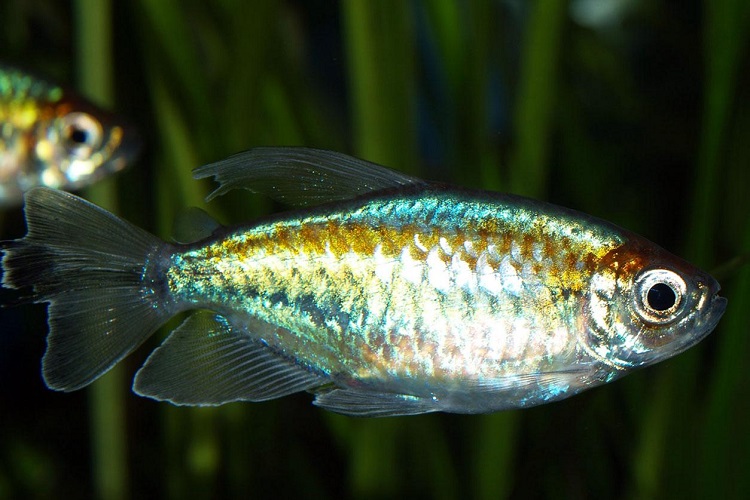
Scientific Name: Phenacogrammus Interruptus
Lifespan: 3-5 years
Average Size: 3–3.5 inches
Tank requirement: 20 gallons
The Congo Tetra originated in the rivers of the Congo Basin in Africa. It is a colorful fish with an iridescent sheen feature. As it swims throughout the tank, you’ll notice its wide range of vibrant tropical hues, including purple and blue and bright orange.
There’s also a clear stripe that runs down their body from head to tail that reflects most of the orange color.
They are generally peaceful and calm fish in nature, and they feel most comfortable when they are in groups of their relatives. They get scared easily and don’t like too bright and loud surroundings.
Environment
Their aquarium water should have a 6.0-8.0 pH level, with a temperature between 73°F-82°F. You should filter the water in the tank regularly because this freshwater fish is susceptible to any new contaminants and poor water quality.
Food and Diet
The Congo Tetra eats insects, worms, plant matter, and algae. You can also include a combination of Daphnia, brine shrimp, Dloodworms, and tubifex.
They’re high in protein, Omega 3, and 6 fatty acids which help keep the gleaming colors of this fish.
21. Jaguar Cichlid
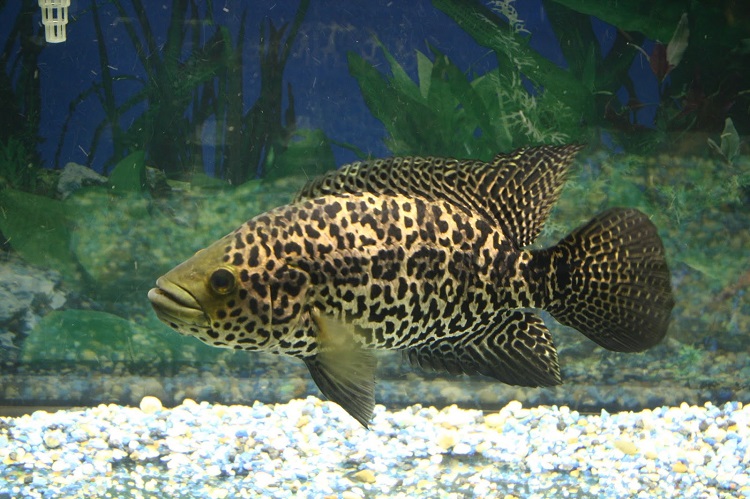
Scientific Name: Parachromis Managuensis
Lifespan: 15 years
Average Size: 12-14 inches
Tank requirement: 70 gallons
The Jaguar Cichlid is usually silver in color, although it can also be bronze or gold. The huge black splotches all over the body are a typical feature of this species.
When the Jaguar Cichlid is very young, these stripes appear to be broad black bands circling the fish, but as it matures, those stripes separate and turn into blotches.
The Jaguar Cichlid is aggressive and territorial. They see other fish as hazards, and they will bite, nip, or eat any smaller fish that enters their territory.
This fish spends the majority of its time near the bottom of the tank and is an active fish so you should give it plenty of room to swim around.
Environment
Jaguar Cichlids prefer water with a hardness of 10-15 dH, and with a pH between 7.0 and 8.5. The ideal temperature range for this freshwater fish is 73-82°F.
The Jaguar Cichlid is a digger and will often uproot live plants in its search for food. Rocks, driftwood, and other decorations can be used to create caves and hiding places for your fish.
Food and Diet
The Jaguar Cichlid is a meat-eater, and it will attempt to consume any small live things in its tank. Fresh or frozen blood worms, brine shrimp, and arthropods are good food choices for your Jaguar Cichlids.
22. Paradise Fish
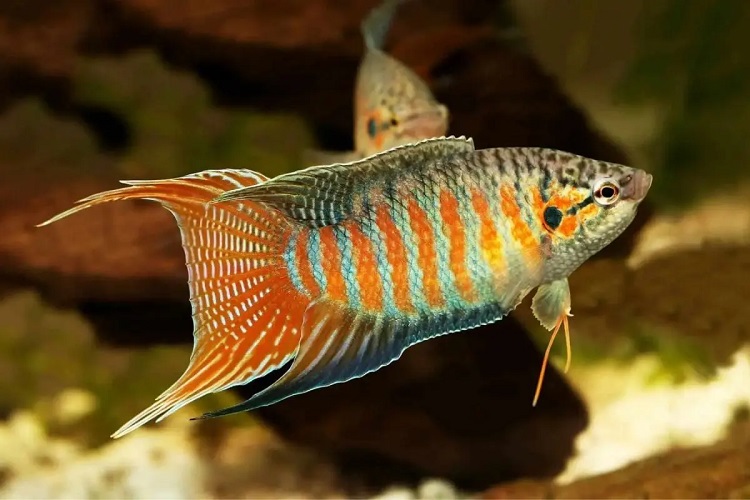
Scientific Name: Macropodus Opercularis
Lifespan: 8-10 years
Average Size: 2-3 inches
Tank requirement: 20 gallons
The Paradise fish is a species of Gourami native to Asia. This kind of fish has brilliant blue and red stripes that run down its body. Its long flowing fins are attached to the body and may take a variety of shapes.
People are frequently put off by this species’ aggressive disposition. They might be quite tough to handle, so getting some prior experience in taking care of fish is recommended before adding this freshwater fish to your tank.
Environment
Although, a sandy substrate would most closely mimic their natural environment, having plants in your is much more essential because they will function as their hiding places.
To give them a comfortable environment, maintain a temperature of 70-82°F using a heater.
The pH level may be either acidic or alkaline, and the water’s hardness level should range from 5-30 dH. Remember to change your tank water regularly to keep it clean and keep nitrate levels as low as possible.
Food and Diet
Their diet consists of live, frozen, or freeze-dried foods. Some of the best choices are Bloodworms, brine shrimp and Daphnia.
You can also supplement their diet with pellets or flakes designed for top-feeding fish. Include vegetables in their diet as well, and make sure to feed them foods that are high in protein.
23. Florida Flag Fish

Scientific Name: Jodanella floridae
Lifespan: 2-3 years
Average Size: 2.5 inches
Tank requirement: 10-20 gallons
This colorful fish is found in Florida and originated in the Yucatan Peninsula.
They are adaptable, and they can readily mingle with other species, particularly the same size. Also, this kind of fish is active and will zoom around the tank throughout the day so it is best to pair them with equally active fish.
Its name comes from the speckled appearance of the blue, red, and white on its body that resembles the American flag.
Environment
Florida flag fish are jumpy fish, which means they will leap out of the tank on the top layer if possible. Given this behavior, make sure the aquarium is always covered.
The ideal water temperature for American Flagfish is 64-72°F with a pH level of 6.2-8.2, and hardness of 6-20 dH.
Food and Diet
Because they are top dwellers, flaky food is better than pellets that sink to the bottom of the tank. Besides the store-bought food, vegetables are an excellent addition to their diet.
Some of the live food you can give your Florida flag fish are brine shrimp, bloodworms, and daphnia. You can also feed them with vegetables like peas, cucumber, and zucchini.
Conclusion
If you’re looking for a little more color in your fish tank, or are just starting and want to know what kinds of fish are good for beginners, then these 23 colorful freshwater fish are perfect for you.
From the brilliantly-colored cichlids to the aggressive but beautiful bettas, there’s a wide variety of dazzling fishes to choose from. So get ready to add some new life and color to your aquarium!m

Ian Sterling, founder of Fishlab.com, began his aquarium journey over 30 years ago, driven by a deep fascination for fish and their diverse personalities. His website, Fishlab.com, is dedicated to making fishkeeping accessible and enjoyable, offering beginner-friendly guidance, expert insights, and a community for aquarists to connect and share experiences.


